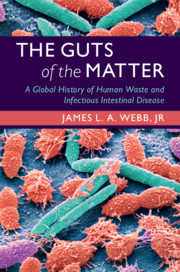Book contents
- The Guts of the Matter
- Studies in Environment and History
- The Guts of the Matter
- Copyright page
- Dedication
- Contents
- Figures
- Acknowledgments
- Introduction
- 1 Pathogens and Parasites
- 2 Early Change
- 3 Diffusion and Amplification
- 4 Innovations
- 5 Adoptions and Adaptations
- 6 The Struggle against Hookworm Disease
- 7 An Era of Optimism
- 8 Global Health and Infectious Intestinal Disease
- Conclusion
- Bibliography
- Index
3 - Diffusion and Amplification
Published online by Cambridge University Press: 18 November 2019
- The Guts of the Matter
- Studies in Environment and History
- The Guts of the Matter
- Copyright page
- Dedication
- Contents
- Figures
- Acknowledgments
- Introduction
- 1 Pathogens and Parasites
- 2 Early Change
- 3 Diffusion and Amplification
- 4 Innovations
- 5 Adoptions and Adaptations
- 6 The Struggle against Hookworm Disease
- 7 An Era of Optimism
- 8 Global Health and Infectious Intestinal Disease
- Conclusion
- Bibliography
- Index
Summary
Chapter three, “Diffusion and Amplification,” discusses the long era in which pathogens and parasites were extended to new regions. As human communities became more complex, networks of trade expanded and became denser, allowing for the rapid, long-distance transmission of intestinal pathogens. Over the first millennium and a half of the Common Era, the disease pool of Eurasia and northern Africa became increasingly integrated. In the late fifteenth century, some Old World intestinal pathogens crossed the Atlantic and became established in the Americas. By the early nineteenth century, the integration had become global. Rapid urbanization in the industrializing North Atlantic states created a crisis of urban fecal pollution. In response, the first public health reform movements emerged. Beginning in the first half of the nineteenth century, cholera pandemics spread along global trade routes and infected all the inhabited continents. This provoked the first efforts at the international control of disease.
- Type
- Chapter
- Information
- The Guts of the MatterA Global History of Human Waste and Infectious Intestinal Disease, pp. 42 - 64Publisher: Cambridge University PressPrint publication year: 2019



